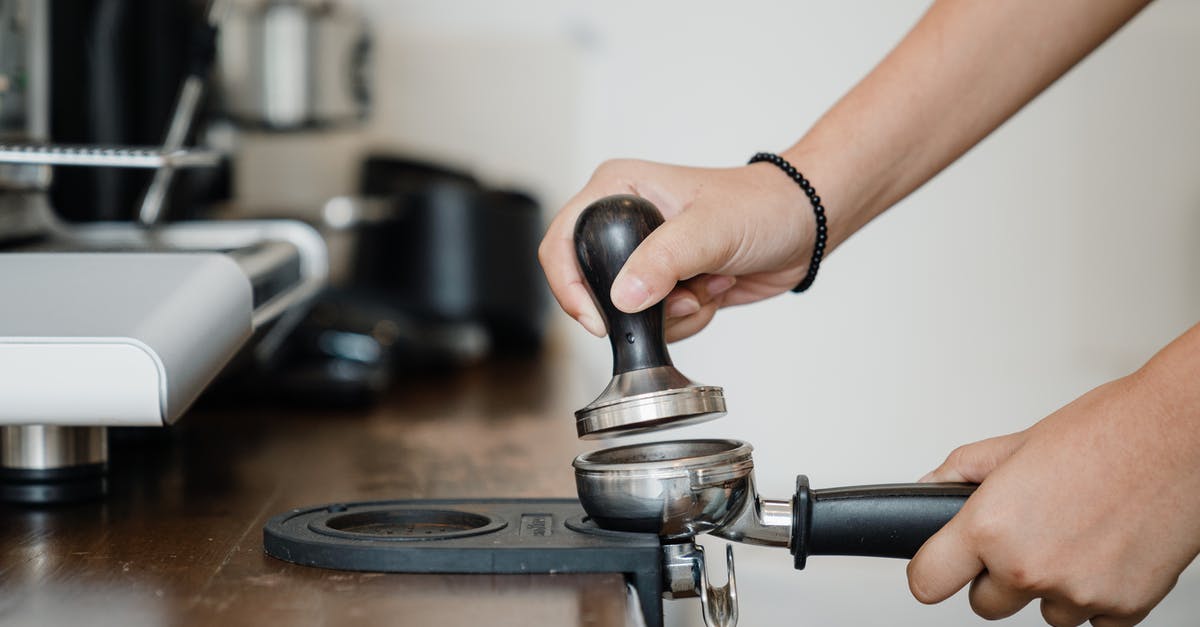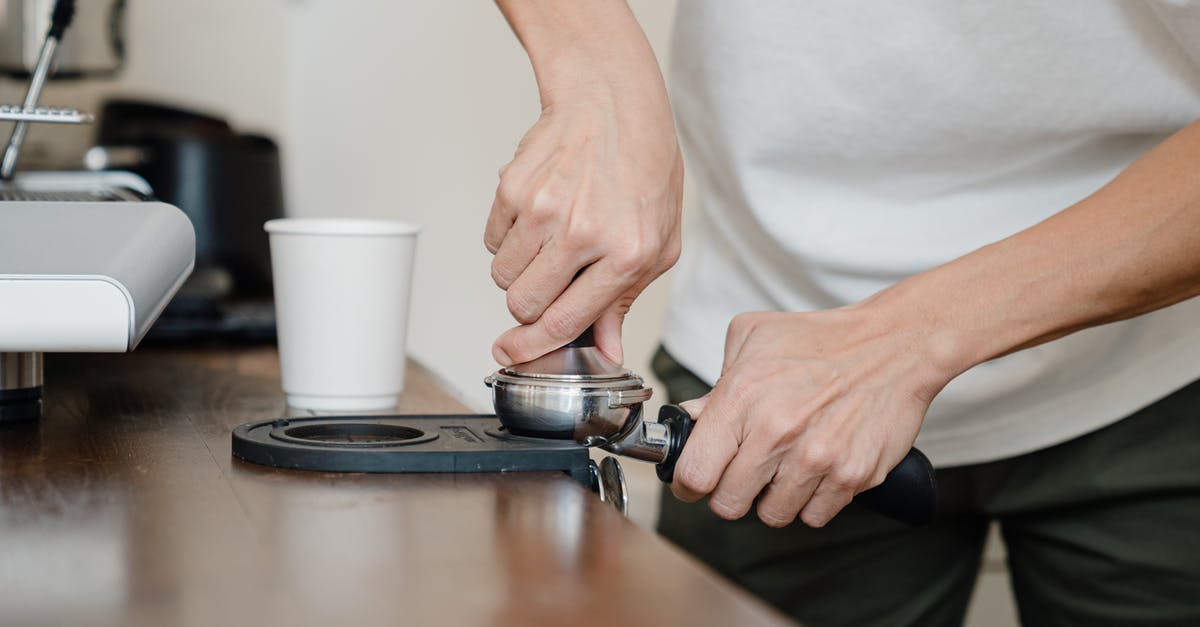French-press coffee has a powdery taste

I recently ordered a French press (Bodum Kenya) and a ceramic conical burr grinder. I've tried this with two different decaf blends from Vermont Coffee Company, one which I ground at the store four days prior and one which I purchased in bean form and ground immediately before brewing.
With both cups, I experienced a weird, astringent powdery taste (arguably closer to a sensation) on the end of my tongue. I made an extra cup from the pre-ground and used hotter water (200 degrees instead of 190) and it seemed to help slightly, but it didn't fix the problem.
My methodology was as follows: heat the water, then while it's going fill my press with hot water (to heat it up, to minimize heat loss and prevent cracking) before I grind the beans. Then when the water boiled I temped the water until it hit 200 degrees even, dumped the priming water from the press, and then filled it with three scoops of coffee and roughly twelve ounces of water (my press's beaker is unmarked.)
Finally, I waited nearly four minutes before pouring.
Any idea what's going wrong here? I'm not getting much aroma or body, either. The grinder I'm using is made by Hario, and is a hand-crank conical burr grinder which received excellent reviews.
Update: As an experiment, I tried grinding a fine batch for the purposes of testing it in my bland (but unoffensive) Senseo. I learned two things: one, my brand new burr grinder has a skewed burr which screws up the consistency of the grind, and two, most of the offtastes I detected are still present. I'm drawing two conclusions:
- I'm using WAY more coffee for the french press than I am for the pod-brewer
- My grind probably isn't helping matters
- I do not like this roast at all anyway.
I'm returning the grinder and I will order something else. In the meantime, I've ordered a bag of whole-bean Lavazza I know I like, so that if this problem reoccurs I'll be diagnosing the issue against a blend I have specific and extensive knowledge of.
Update 2: I've substantially increased the size of my grind, and made three sequential cups with smaller and smaller grinds. At the current spot I produce a decently-aromatic 12 ounces with just under two scoops of beans, and it's completely without either the sour or powdery characters it previously suffered. It still tastes weak, though, despite a faint velvety richness which I think is indicative of what this coffee should taste like.
Increasing the amount of coffee brings back the sourness, but not the powdery taste. Interestingly, in this case the spent grounds smell quite nasty - the sour taste dialed up to 11. I'm going to finish the bag of beans and replace the grinder and see where it takes me - and once the equipment issue is resolved I'll be back to report and accept an answer.
Best Answer
You didn't mention the size of your grind. You definitely want a course to medium grind. A fine/espresso grind will leave a lot of sediment and produce a bitter cup of coffee from over extraction.
Two things you can do to minimize sediment:
After letting it brew, before plunging, use a couple of spoons to scoop out as much of the coffee grounds as you can. This video shows a demonstration of this.
Decant the coffee. Pour the coffee from the press into another jug and let it settle a moment before pouring into your cups.
Another tip: Place a saucer over the top of the press for the four minutes to minimise heat loss.
Pictures about "French-press coffee has a powdery taste"



Why does my French press coffee taste chalky?
Probably the biggest cause of too much sediment is poor grind uniformity. When you grind lazily or with cheap tools like a blade grinder you end up with grounds of many sizes. The smallest of these grounds\u2014\u201dfines\u201d\u2014slide right through the filter.Why does my coffee taste Sandy?
If you don't let it settle, you'll have a lot of the coffee grinds floating in the cup and it'll have a powdery texture (although it should be overly gritty given the fineness of the grind).How do you make French press coffee taste better?
Top 10 Tips for Better French Press Coffee at HomeWhat is French Press supposed to taste like?
What's the flavour of French press coffee? Due to the design and brewing process, a French press delivers a bold and rich taste unlike any other. For French press coffee, the grinds stay in the bottom of the beaker throughout the entire process.How to Make a French Press Coffee (that tastes good)
More answers regarding french-press coffee has a powdery taste
Answer 2
French press coffee is going to inevitably have more of the grounds, that make it through the filter, than some other methods of coffee making. Some people dislike this about the method--I don't personally have a problem with it, and think French Press is one of the best simple ways of making coffee.
To minimize the amount of sediment in your cup:
- Use a high quality grinder, which will give a more a more even grind, with less dust which will get through the filter. You have said you are already using a burr grinder which usually offers a high quality grind.
- French Press uses a more coarse grind than other types of brewing; make sure you are grinding at the appropriate size.
- Let the coffee sit for a few second after you press it for the remaining sediment to settle; then, don't pour out the last bits of coffee, which is where the most sediment will remain.
This article at I Need Coffee is a step by step guide on French press coffee, with a good picture of the grind size, including a nickel for scale.
They also suggest a device called a "Coffee Catcher" (which evidently is now out of production, but may still be available) to help minimize the sedimient. I cannot speak to the efficacy of the device.
Answer 3
French press coffee is a science experiment every morning.
Consistency is hard, but possible.
A. Learn your batch of beans: Every batch is different, even batches of the same bean and roast.
B1. Have a baseline grind. For French press, the baseline should be coarse. Grind some beans at your baseline grind and make some coffee. How's it taste? Too "chewy" or "powdery" or "silt-y", the grind needs to be more coarse. Too watery, less coarse. You have to learn the grind for every batch, even batches of the same beans and roast. Every one will be different, but not dramatically so.
B2. Caveat: Too much coffee can contribute. The quantity of beans per batch is something you have to determine for yourself (to taste). I find that darker roasts requires less beans (25-30 grams beans for 750 grams water) than medium roasts (30-35 grams beans for 750 grams water).
C. Grinder. You don't need a burr grinder, but you do need a grinder. A $20 Krups will do just fine. You DO need technique, however: "For this batch of beans, I need this grind." It will be different for every batch, even batches of the same roast. Use a baseline (i.e. that looks about right) and make some coffee at that baseline. Then adjust coarseness and quantity up or down. If it's hard to press the press, the coffee it far too finely ground. (On second thought, I guess a burr grinder with settings could help with consistency. I just eyeball it now that I've sold my great, but ultimately superfluous http://www.baratza.com/cgi-bin/commerce.cgi?search=action&category=RGRD.
D. Temperature. 200 F might be too high for the beans you are using. I find 195-197 F for French press works well for most beans. I doubt the temperature has anything do with what you're experiencing, but temperature is 90% of making great coffee: getting the right temp. for the bean, holding it at temp for brew, getting it to the cup without losing too much heat, etc. Do you put boiling water in your coffee cup to preheat it? Is it a covered cup? If not, you'll lose as much as 20 F going from press to cup. More if you add cream and sugar, which are 33-41 F and room temp., respectively. Temperature is everything in coffee. You have to put a lot of effort into getting it right from the time the water hits the beans to the time it hits your tongue. It's a finely-tuned game of getting the temperature right.
E. Rest. If you preheat your covered cup, then you can let your coffee rest for a minute or two before you drink it. This allows the sediment (which isn't filtered as well in a French Press) to settle to the bottom of the cup.
In short, it's the sediment that gives French Press a powdery/chewy/taste. Limit it by learning how to grind each batch of beans and (if possible) letting your coffee rest a minute or so before drinking.
Answer 4
The Bean
Firstly an important note, always purchase freshly roasted whole coffee beans and do your own grinding. There are roughly 800 volatile molecular components found in coffee and much of it evaporates within several days of resting and/or minutes after grinding.
The Grind
In coffee grinding parlance, "boulders" is used to describe chunks and "fines" is used to describe microfine particles. When you introduce water (in any extraction method), the "fines" give up their flavor quickly, adding bitterness when overextracted, and the boulders hardly give up anything at all, leaving a thin and sour underextracted flavor. The goal for grinding coffee is consistency of the grind, everything should be relatively the same size so it extracts evenly.
This is where the Hario Skerten makes a horrible grinder for any brew, the wobble in the burrs results in an extremely inconsistent grind and rather random brewing results. There are kits available for mounting a bottom bracket to fix the wobble, or you can simply get a higher quality burr grinder that has both an upper and lower bearing.
Here's a video describing the Hario Skerton and Kyocera in detail.
If you haven't adjusted the grind size already, you should be producing a consistent grind the size of breadcrumbs for French Press brewing.
The Resulting Brew
A chalky/powdery result comes from the fines making their way through the metal screen on the press. Ideally, your goal should be zero fines for your French Press brew. A coffee hack you can do to get around this is to shake your freshly ground coarse coffee in a small metal sieve so the fines fall through. Do this over something white to easily determine the amount of fines your grinder is producing. I have also seen natural static as a useful by-product of grinding that prevents fines from exiting the grinder.
For French Press extraction, make sure you dispense all of the beverage from the brewer when your brewing is complete. Leaving the grinds sitting in the coffee results in overbrewing for the next cup.
Cheers!
Sources: Stack Exchange - This article follows the attribution requirements of Stack Exchange and is licensed under CC BY-SA 3.0.
Images: Ketut Subiyanto, Ketut Subiyanto, Ketut Subiyanto, Ave Calvar Martinez
